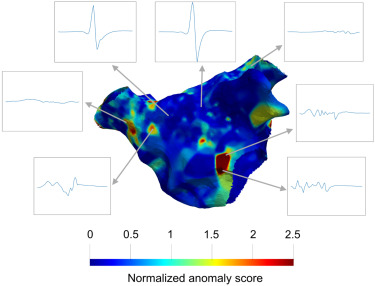![]() A new paper investigates deep anomaly detection algorithms to characterise arrhythmic substrate in atrial fibrillation patients
A new paper investigates deep anomaly detection algorithms to characterise arrhythmic substrate in atrial fibrillation patients
![]() The authors used OpenEP to calculate established substrate indicators from electroanatomic maps of left atria
The authors used OpenEP to calculate established substrate indicators from electroanatomic maps of left atria
![]() They also investigated new indicators based on deep anomaly detection
They also investigated new indicators based on deep anomaly detection
![]() The new indicators were correlated with each other and the established indicators
The new indicators were correlated with each other and the established indicators
![]() This work has the potential to improve the clinical understanding and treatment of persistent atrial fibrillation
This work has the potential to improve the clinical understanding and treatment of persistent atrial fibrillation
The purpose of this blog post is to highlight a new paper by Bindini et al. [1] which makes use of OpenEP. This paper addresses the question of how electroanatomical data acquired during sinus rhythm can help identify arrhythmogenic regions in patients with persistent atrial fibrillation. Various indicators of arrhythmic substrate have been studied, e.g. peak-to-peak voltage, fractionation index, and duration.
The authors investigated new indicators based on deep anomaly detection of the cardiac electrograms. They considered various deep neural network architectures for this task: a variational autoencoder (VAE), a memory-augmented autoencoder (MemAE), and Deep Support Vector Data Description (Deep-SVDD). Only the morphology (i.e., not the amplitude) of the electrograms was considered to obtain an anomaly score for each electrogram signal.
Left atrium of a patient coloured according to the Deep-SVDD anomaly score [1]
The authors also used OpenEP to calculate three traditional indicators of atrial substrate: peak-to-peak voltage, fractionation index, and duration. The new anomaly scores were correlated with each other, as well as with the traditional indicators. There is some indication that maps based on deep anomaly detection give a more easily interpretable characterisation of areas with abnormal electrical activity.
This paper introduces a promising new methodology which may add to the clinical understanding of atrial fibrillation. By constructing electroanatomic maps of anomaly scores, which could be used to highlight electrical abnormalities, the authors take a step towards clinical translation of this method. An exciting example of the possibilities enabled by open source electrophysiology software!
[1] Bindini, L. et al. (2024) ‘All-in-one electrical atrial substrate indicators with deep anomaly detection’, Biomedical Signal Processing and Control, 98, p. 106737. doi:10.1016/j.bspc.2024.106737.
